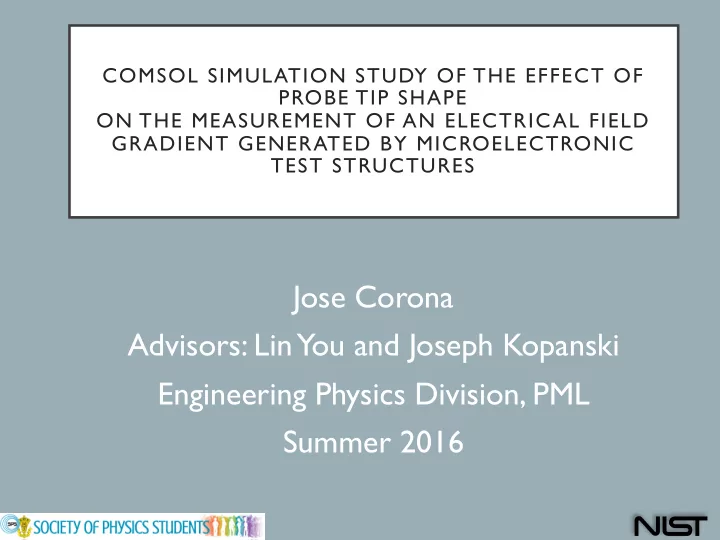

COMSOL SIMULATION STUDY OF THE EFFECT OF PROBE TIP SHAPE ON THE MEASUREMENT OF AN ELECTRICAL FIELD GRADIENT GENERATED BY MICROELECTRONIC TEST STRUCTURES Jose Corona Advisors: Lin You and Joseph Kopanski Engineering Physics Division, PML Summer 2016
OUTLINE Ø Theory Ø Results Ø Conclusions Ø Scanning Kelvin Force Ø Importance of tip shape Ø Future Work Microscopy (SKFM) Ø Cantilever Effect Ø References Ø Motivation Ø Importance of Tip Shape Ø COMSOL Model Ø Clearance Effect Builder Ø Differential Voltage Ø Different Size Ratios 2
MOTIVATION Ø Precise nano-scale measurements Ø Use of Scanning Kelvin Force Microscopy (SKFM) Ø Electric Field Measurements are HIGHLY dependent on the shape of the probe Ø Design an Electrical Tip Image from Semiconductor Manufacturing & Design Community Shape Profiler Reference Material 3
WORKING PRINCIPLES OF SKFM (Kaja’s PhD THESIS 2010) Image credit: Kaja Ø Tapping Mode vs. Mode Lift 15° Scanning Kelvin Force Microscope (SKFM) 4
COMSOL MODEL BUILDER Fig. 5 Domain Probe Image credit: Kaja (Kaja’s PhD THESIS 2010) 5
COMSOL MODEL BUILDER Air Materials Copper Glass 6
COMSOL MODEL BUILDER Electrostatics Floating Potential Ø Charge Conservation Ø Zero Charge Ø Floating Potential Ground Ø Biasing Ø Ground +10V 7
COMSOL MODEL BUILDER Meshing 8
COMSOL MODEL BUILDER Parametric Sweep ∠𝑢𝑗𝑞 Clearance 9
IMPORTANCE OF TIP SHAPE Surface Potential of Lateral Scan 2 1.8 Ø The Surface Potential Surface Potential [V] 1.6 1.4 dependency on the 1.2 shape of the tip 1 0.8 Ø Sharper vs. Blunter 0.6 0.4 tips 0.2 0 Ø 5° -2 0 1 2 3 4 5 -5 -4 -3 -1 Position [ µ m] Ø (-2.52 , 0.140) 5° 20° 35° 12.5° 27.5° Ø ( 2.66 , -0.149 ) Instantaneous Surface Potential at any Given Point Ø 35° 0.2 Derivative Surface Potential [dV] 0.15 Ø ( -2.52 , 0.101 ) 0.1 0.05 Ø ( 2.66 , -0.113 ) 0 -2 0 1 2 3 4 5 -0.05 -5 -4 -3 -1 -0.1 -0.15 -0.2 Derivative Position [d µ m] 5° 12.5° 20° 27.5° 35° 10
CANTILEVER EFFECT Cantilever Effect 0.15 5deg 0.1 25deg Surface Potential [V] 45deg 0.05 FP 0 0 5 10 15 -15 -10 -5 -0.05 -0.1 -0.15 Position [um] +10V Cantilever Effect 0.25 GRD 0.2 5deg 0.15 Surface Potential [V] 0.1 25deg 0.05 45deg 0 0 5 10 15 Glass -15 -10 -5 -0.05 -0.1 -0.15 -0.2 -10V -0.25 Position [um] 11
CLEARANCE EFFECTS ON SURFACE POTENTIAL 5º Cone Angle KFM Scan 0.6 10nm Surface Potential [V] 0.5 43nm 77nm 0.4 110nm 0.3 144nm 0.2 177nm 210nm 0.1 244nm 0 -2.5 -2 -1.5 0 0.5 1 1.5 2 2.5 277nm -1 -0.5 310nm Glass Position [ µ m] +10V 35º Cone Angle KFM Scan GRD 0.45 10nm Surface Potential [V] 0.4 43nm 0.35 0.3 77nm 0.25 110nm 0.2 144nm 0.15 0.1 177nm 0.05 210nm 0 -2.5 -2 -1.5 0 0.5 1 1.5 2 2.5 244nm -1 -0.5 Position [ µm] 277nm 12
CLEARANCE EFFECTS ON SURFACE POTENTIAL 5 º Cone Angle KFM Scan 2 1.8 Surface Potential [V] 1.6 1.4 1.2 1 0.8 10nm 0.6 20nm 0.4 0.2 0 -2 0 1 2 3 4 5 6 -6 -5 -4 -3 -1 Position [ µ m] GRD Glass +10V 35º Cone Angle KFM Scan 1.6 Surface Potential [V] 1.4 1.2 1 0.8 10nm 0.6 20nm 0.4 0.2 0 -2 0 1 2 3 4 5 6 -6 -5 -4 -3 -1 Position [ µm] 13
DIFFERENTIAL VOLTAGE Ø 5 º Cone Angle Surface Potential of Rectangular Scan with Conical Tip 1.8 highest SP and most narrow width 1.6 Ø Coherent 1.4 results as Surface Potential [V] 1.2 5°(10nm) before 5°(20nm) 1 Ø Smaller lift 35°(20nm) 0.8 height, higher 35°(10nm) 0.6 SP 20°(20nm) 0.4 20°(10nm) 0.2 0 0 5 10 15 -15 -10 -5 Position [ µm] (20-10)nm Determining the Width of the Tip 0.005 0 Differential Voltage [dV] -15 -14 -13 -12 -11 -10 -9 -8 -2 0 1 2 3 4 5 6 7 8 9 10 11 12 13 14 15 -7 -6 -5 -4 -3 -1 -0.005 -0.01 5° 35° 20° -0.015 -0.02 Position [ µm] 14
DIFFERENT SIZE RATIOS Lateral Scan of 2:1 Eccentric Cone Short side 1.8 1.6 1.4 Long side Surface Potential [V] 1.2 1 10nm longside 0.8 10nm shortside 0.6 0.4 0.2 0 1.6 -2 0 1 2 3 4 5 6 -6 -5 -4 -3 -1 Position [ µ m] Lateral Scan of 5:1 Eccentric Cone 1.4 Ø Noticeable gap 1.2 1 Surface Potential [V] 0.8 Ø Indicates the longside 0.6 shortside direction of scan 0.4 0.2 0 -2 Position [ µ m] 0 1 2 3 4 5 6 -6 -5 -4 -3 -1 15
SUMMARY AND OUTLOOK Ø Extract: Ø Base shape Ø Tip angle Ø Height Ø Future work: Ø Compare 16
THANK YOU! Any Questions? References How AFM Works: Scanning Kelvin Probe Microscopy (SKPM) , Web. • (http://www.parkafm.com/index.php/medias/nano-academy/how-afm- works#prettyPhoto). Khaled Kaja . Development of nano-probe techniques for work function • assessment and application to materials for microelectronics. Physics. Universite Joseph-Fourier - Grenoble I, 2010. English. <tel-00515370> http://semimd.com/insights-from-leading-edge/2010/10/02/iftle-18- • the-3d-ic-forum-at-2010-semicon-taiwan/ 17
CONCLUSIONS Ø COMSOL’s ability to simulate SKFM Ø Effect of Tip on the Surface Potential Measurement Ø Seen through development of many DUTs Ø IF SLOPE DETERMINED INSERT HERE Ø Various lift heights affect Surface Potential Ø Differential Voltage Produced Ø V 18
GOALS • 3D COMSOL Simulation of Scanning Kelvin Force Microscopy (SKFM) • SKFM à Electric field measurements • Determine the field distribution to design Electrical Tip Shape Profiler Reference Material • Cone Angle • Base • Height 19
THEORY OF SURFACE POTENTIAL Image from HyperPhysics Coulomb’s Law – Electric force between charges Image from HyperPhysics Electric Potential – work per unit charge to move a point charge Gauss’s Law – Used to determine the Electric field of a Gaussian surface http://hyperphysics.phy-astr.gsu.edu/hbase/electric/elewor.html#c2 Image from HyperPhysics 20
VAN DER WAAL’S FORCES Image by http://www.eng.usf.edu/~tvestgaa/ThinFilm/ 21
http://mathworld.wolfram.com/FullWidthatHalfMaximum.html 22
Recommend
More recommend